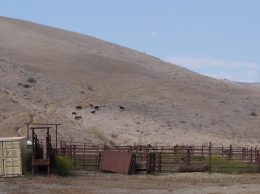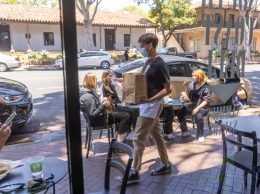
For months, many farmworkers in the tri-county region and the rest of California, especially indigenous workers who speak neither Spanish nor English, were not properly informed of the dangers of COVID-19, leading to outbreaks and poor working conditions.
Despite being labeled essential workers by the state, farmworkers often felt ignored, according to a recent study led by the California Institute for Rural Studies. The institute released Phase Two of its study on Feb. 2, based on in-depth interviews conducted in 2020 with 63 farmworkers from around the state, including seven from the Tri-Counties.
“When we talk to these communities, especially indigenous communities, I think the problems were that they never receive information. All the information was in Spanish and English, but not in indigenous language,” Oralia Maceda, the program director at Centro Binacional para el Desarrollo Indígena Oaxaqueño (CBDIO), told the Business Times.
Growers and local government officials say they have improved their response throughout the pandemic, and point to recent efforts including a new program to get vaccines to farmworkers in Ventura County.
Centro Binacional, based in Fresno, was one of the groups that helped conduct the interviews, including on the Central Coast.
The biggest issue, Maceda said, was that information on the pandemic was not often translated to Mixteco and other indigenous languages.
“Just imagine that you are in some place that no one can understand your language. How are you supposed to express what you feel, what you need to do?” Maceda said.
Though the majority of farmworkers do come from Mexico, not all of them speak Spanish. Rather, they speak indigenous languages that include Mixteco, Purepecha and Zapotec.
Irene de Barraicua, public relations manager at Lideres Campesinas in Oxnard, also helped CIRS with the study. She recalled a September trip to a farm in Ventura County to give workers chips, drinks and masks, and noted how bad the situation was.
“They all crowded around my car but I had to tell them, there is a virus, you can’t be so close. And then I noticed that they are all cramping into these small cars and commuting and it was just obvious to me they haven’t been told any of this information,” de Barraicua said.
And because many workers were ill-informed, many were taken advantage of. The CIRS study found that many workers were not given the proper precautions necessary to take care of themselves, such as masks, hand washing stations and paid sick leave.
One farmworker from the tri-county region noted in the study how difficult it was to receive any help from support hotlines established by state and county offices to provide guidance, advice or information about services.
“There’s no help,” the worker said. “Sometimes they give a number and one calls, but no one answers or they just tell you that they’ll call you back and up to now, no one has called us.”
Despite only 63 workers being interviewed for Phase Two of the study, Maceda said her organization has conducted over 300 interviews, 242 of which were done with farm workers from Ventura, Santa Barbara or San Luis Obispo counties.
“It was sad, and in some cases I felt angry, because why don’t they have the same rights?” she said. “We are human so why don’t we have the same privilege? Why can I work from my home but they have to expose their lives on the field?”
Though she said all regions had a poor response, de Barraicua lauded the efforts of Ventura County.
The Ventura County Agricultural Commissioner’s Office has issued over 1 million masks to growers, while the county’s Farmworker Resource Program has provided direct translation for indigenous speakers and other assistance.
Ventura County Agricultural Commissioner Ed Williams said his office has heard the concerns about a lack of masks and other essentials, but he said that’s “the exception rather than the rule in Ventura County.”
“I can’t speak for every farmer in the county, all I can say is that we’ve made those materials available as much as possible,” he said.
The county has also made arrangements so that a farm worker with COVID-19 who lives in a multi-family dwelling can safely isolate in a hotel room, where they will be fed and checked on.
Early in the pandemic, there were outbreaks in the region’s agricultural industry, including at a packing house in Santa Paula and a farmworker dormitory in Oxnard. But those type of large outbreaks have been much rarer in recent months, even as the virus has become more prevalent in the region.
Dan Sutton, general manager of the Pismo Oceano Vegetable Exchange near Paso Robles, said the industry in San Luis Obispo County has taken the pandemic seriously.
“We have the safety protocols and the safety PPE and the necessary materials to promote those things have been top priority, and we have made sure that those things are provided,” he said. “I’m impressed with what we have done. I’m really impressed with the concern, the resources that people have laid out, and the focal point of all of this being about protecting the employees.”
As vaccine rollout steps up, Ventura County began a pilot program on Feb. 11 to get vaccinations out to farmworkers, Williams told the Business Times.
“It’s on a very small scale but we are going to try to do this as quickly as we have the vaccinations available,” Williams said.
Things have gotten better in the months since many of the study’s interviews were conducted, the last of which were done in October. Still, de Barraicua said, more should have been done sooner.
“An executive action by the governor to do everything that has now kind of been done would have helped, but there is so much grower influence and power that made it hard to do,” she said. “You’ll see big smiles and open arms from the growers when it comes to vaccinating the workers, but it should have been the same way when it came to having health care professionals come and educate or having testing on the fields, but it wasn’t. It was like pulling teeth.”






 Print
Print Email
Email

















